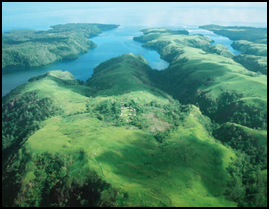
It is estimated that more than a thousand different cultural groups exist in Papua New Guinea. Because of this diversity, many different styles of cultural expression have emerged; each group has created its own expressive forms in art, dance, weaponry, costumes, singing, music, architecture and much more.
Most of these different cultural groups have their own language. People typically live in villages that rely on subsistence farming. To balance their diets, they go hunting and collect wild plants (such as yams roots) for food. Those who become skilled at hunting, farming and fishing earn a great deal of respect.
Sea shells are no longer the currency of Papua New Guinea, as they were abolished as currency in 1933. However, this heritage is still present in local customs; in some cultures, to get a bride, a groom must bring a certain number of golden-edged clam shells as a brideprice. In other regions, brideprice is paid in lengths of shell bead money, pigs, cassowaries and cash.
People of the highlands engage in colorful local rituals that are called "sing sings". They paint themselves, and dress up with feathers, pearls and animal skins to represent birds, trees or mountain spirits. Sometimes an important event, such as a legendary battle, is enacted at such a musical festival.